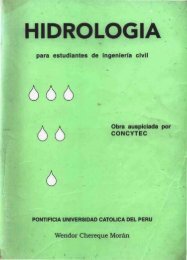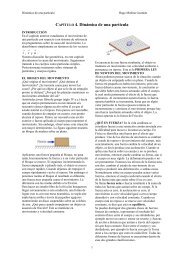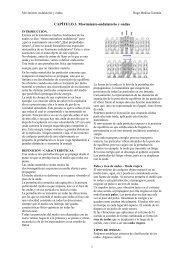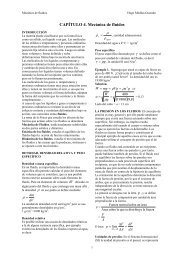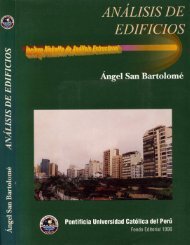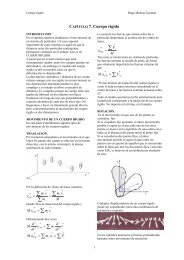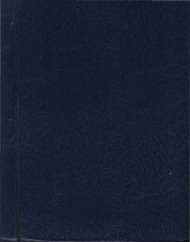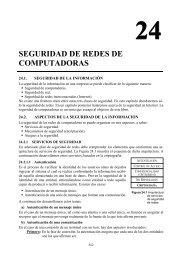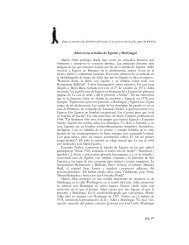CAPÍTULO 5. Termodinámica - Biblioteca
CAPÍTULO 5. Termodinámica - Biblioteca
CAPÍTULO 5. Termodinámica - Biblioteca
You also want an ePaper? Increase the reach of your titles
YUMPU automatically turns print PDFs into web optimized ePapers that Google loves.
Calor y <strong>Termodinámica</strong> Hugo Medina Guzmán<br />
n = 1,<br />
litro.atm<br />
R = 0,<br />
0821<br />
mol.K<br />
En a ⎧ p = 2 atm<br />
2× 10<br />
a<br />
⎨<br />
Luego T = = 243,6 K<br />
⎩Va<br />
= 10 litros 0,<br />
0821<br />
En b ⎧ pb<br />
= 2 atm<br />
2× 30<br />
⎨<br />
Luego T = = 730,8 K<br />
0,<br />
0821<br />
⎩V<br />
b<br />
= 30 litros<br />
⎧ p = 1atm<br />
1× 30<br />
c En c ⎨<br />
Luego T = = 365,4 K<br />
⎩Vc<br />
= 30 litros 0,<br />
0821<br />
⎧ p = 1atm<br />
1× 10<br />
d En d ⎨<br />
Luego T = = 121,8 K<br />
⎩Vd<br />
= 10 litros 0,<br />
0821<br />
b)<br />
De a → b (presión constante)<br />
El calor suministrado es Q = C pΔT<br />
Siendo gas ideal (gas monoatómico)<br />
5<br />
C p = nR<br />
2<br />
cal<br />
cal<br />
Como n = 1,<br />
y R = 2 ⇒ C p = 5<br />
mol K K<br />
Δ T = 730,8 – 243,6 = 487,2 K<br />
Q = 5 487,<br />
2 = 2436 calorías<br />
()( )<br />
De b → c (volumen constante)<br />
El calor suministrado es Q = CV<br />
ΔT<br />
Siendo gas ideal (gas monoatómico)<br />
3<br />
C p = nR<br />
2<br />
cal<br />
Como n = 1,<br />
y R = 2<br />
mol K<br />
cal<br />
⇒ C p = 3<br />
K<br />
Δ T = 365,4 – 730,8 = -365,4 K<br />
Q = 3 − 365,<br />
4 = -1096,2 calorías<br />
()( )<br />
De c → d (presión constante)<br />
El calor suministrado es Q = C pΔT<br />
T<br />
=<br />
Δ = 121,8 – 365,4 = - 243,6 K<br />
Q 5 − 243,<br />
6 = -1218 calorías<br />
()( )<br />
De d → a (volumen constante)<br />
El calor suministrado es Q = CV<br />
ΔT<br />
Δ T = 243,6 – 121,8 = 121,8 K<br />
Q = ()( 3 121,<br />
8)<br />
= 365,4 calorías<br />
c)<br />
De a → b (presión constante)<br />
W = p V −V<br />
El trabajo es ( b a )<br />
= 2( 30 −10)<br />
W = 40 litro atm<br />
43<br />
Como 1 litro-atm = 101,3 J = 24,2 cal:<br />
W = 4052 J = 968 calorías (trabajo del sistema)<br />
De b → c (volumen constante)<br />
El trabajo es W = 0 , (no hay trabajo).<br />
De c → d (presión constante)<br />
W = p V −V<br />
El trabajo es ( d c )<br />
= 1( 10 − 30)<br />
W = - 20 litro atm<br />
W = - 2026 J = - 484 calorías (trabajo sobre el<br />
sistema)<br />
De d → a (volumen constante)<br />
El trabajo es W = 0 , (no hay trabajo).<br />
d) Como<br />
3<br />
U = nRT<br />
2<br />
3 ⎛ cal ⎞<br />
= ( 1mol)<br />
⎜2<br />
⎟T<br />
2 ⎝ mol K ⎠<br />
= 3 T<br />
U 3T<br />
3 243,<br />
6K<br />
= 730,8 cal<br />
a<br />
b<br />
= a = ( )<br />
= Tb<br />
= ( 730,<br />
8K<br />
)<br />
= Tc<br />
= ( 365,<br />
4K<br />
)<br />
= T = ( 121,<br />
8K<br />
)<br />
U 3<br />
U 3<br />
c<br />
3 = 2192,4 K<br />
3 = 1096,2 K<br />
U d 3 d 3 = 365,4 K<br />
e) Trabajo neto = W ab + Wbc<br />
+ Wcd<br />
+ Wda<br />
= 4052 + 0 – 2026 + 0 = 2026 J<br />
= 487 cal<br />
Calor absorbido = Q ab + Qbc<br />
+ Qcd<br />
+ Qda<br />
= 2436 – 1096,2 – 1218 +365,4<br />
= 487 cal<br />
Trabajo neto = calor absorbido<br />
= Calor que entra – calor que sale.<br />
Ejemplo 87. Considere el proceso cíclico descrito<br />
en la figura. Si Q es negativo para el proceso BC y<br />
ΔU es negativo para el proceso CA:<br />
a) determine los signos de Q asociados a cada<br />
proceso.<br />
b) determine los signos de W asociados a cada<br />
proceso.<br />
Solución.<br />
a) QAB = positivo<br />
QBC = negativo (Dato)<br />
(UC –UB) = QBC -WBC = QCA = negativo<br />
(UA –UB) = QCA - WCA ⇒ = QCA = (UA –UC) +<br />
WCA = (-) + (-) = negativo



